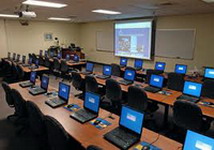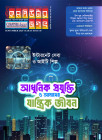হোম > Technology in the Classroom ICT in Education
লেখক পরিচিতি
লেখকের নাম:
মু: খালেদ আহমেদ
মোট লেখা:১
লেখা সম্পর্কিত
পাবলিশ:
২০১২ - জানুয়ারী
তথ্যসূত্র:
কমপিউটার জগৎ
লেখার ধরণ:
শিক্ষা
তথ্যসূত্র:
ইংরেজি সেকশন
ভাষা:
বাংলা
স্বত্ত্ব:
কমপিউটার জগৎ
Technology in the Classroom ICT in Education
Vision 2021:Digital Bangladesh has caught up the imagination of old and young generation as laptops and broadband services have given a new meaning to technology and Internet access, numerous people around the globe are now spending more and more time online doing e-shopping, listening to e-radio, playing e-games, using social media sites or chatting online with their loved ones.
Most of us in cities have at least one active email account on Yahoo, Google or Hotmail. Youngsters are more prone to Internet addiction and owing to the latest inventions like iPad, technology is on the go 24/7.

We use technology for fun, to stay connected, in business extensively, but how often do we use it in education? Are our school students making their assignments online and emailing them? Are our teachers using different presentations and documentaries to teach primary and secondary levels instead of relying only on the course books? Most probably, no! Why? Well, before answering this question, let’s first explore that why should we use Information and Communications Technology (ICT) in our classrooms.
ICT when integrated into the classrooms adds immense value to the quality of teaching, making it a holistic learning experience for the pupils. It makes education student-centered, visual, time-saving and motivates the young scholars to produce creative assignments. When incorporated into the curriculum systematically, it helps the teachers in making the complicated concepts simple and easy to understand. It gives students an opportunity to become a part of the global IT village enhancing their technical and communication skills.
ICT-oriented topics are always quite interesting as teachers get a variety of pictures, movies, spreadsheets and even online quizzes to carry out their lesson plans with. Besides, effective ICT classroom practices produce well-informed, tech-savvy students who are competent enough to survive in the recession-struck 21st century job market.
This makes us wonder that if ICT can support teaching so much, then why it hasn’t been incorporated extensively in education till now. This is because many teachers treat ICT as a standalone activity. They aren’t incorporating ICT in their lesson plans and curriculum. A number of them prefer using a white board/black board to explain the topics. This conventional way of teaching indeed works. However, students confront countless problems in retaining the concepts for longer periods and tend to forget them as soon as the term gets over. The governments as part of Digital Bangladesh initiatives has created computer labs in the schools unfortunately these labs are not used for teaching other subjects except computer courses. The education ministry needs to train the teachers to use these labs for Bangla, English, Mathematics and Science Subjects. It would be better if teachers try to integrate online activities, videos, graphs, databases, templates, articles and presentations in their every day lesson plans to make their explanations clear and interesting. Such resources are easily available on different educational websites and offer a variety of user-friendly levels.
Many curriculum-based websites offer free tutorials, vocabulary tools and quick lesson summaries which can be used in numerous ways in classrooms and at home. Teachers can also use online diagrams and games to explain complex subject matters in an engaging way and even design worksheets to keep their students interested. Besides, since students would have watched and interacted with the technology, chances are that they will remember the topics for a longer time.
Students can be encouraged to write online and email their essays, reports, observations and descriptions. This way it would be easier for them to plan, draft, proofread and present their work with lesser errors and more neatness.
Students of english medium schools following the syllabus of Cambridge and Edexcel use email their assignments as they don’t have to worry about their handwriting or using an eraser. AutoCorrect, spelling and grammar checks in Word help them tremendously. The private schools like Cambrian has also adopted the technology to make their students ready for the future.
Similarly, science and mathematics teachers incorporate ICT to make the most boring lessons come to life. For example, instead of drawing the pie and bar charts on the whiteboard to represent and interpret data in math, teachers can use PowerPoint and Word to explain how charts work. Students can alter the values to see how each proportion changes. They can even collect data from their surroundings and represent it on Power Point or Word. This will help them to represent data professionally in colleges, universities and at their work places in the long term.
ICT can change the entire outlook of present-day education. However, it needs to be planned and structured proficiently to bring a difference in the way our students learn. The government needs to take special attention to ensure that it does not create a state sponsored Digital Divide. The technology ready few thousand lucky students graduating out of these institutions at one time will dominate the millions of unfortunates who never got the opportunity to use ICT for education. Unless the government steps in with definite strategy the country may be heading for larger conflict within the society. Education is probably the most important issue that affects the ability to benefit from technology. Unless people can read and understand what they find on the Internet, all the computers and networks in the world won’t be of much use.
ICT is not a silver bullet that will solve all social and economic problems. This will disappoint those who believe technology can be the greatest equalizing force our society or any other has ever known. If digital divide crusaders really want to solve the rural Bangladesh’s inequities, they should direct their efforts toward key issues that mattered before promoting high technology. Promoting economic growth would be a good place to start.
Government continue to push the prices of fuel, electricity and tax and other things digital. These are resulting in lower income people losing the access to ICT through increase in prices of ICT equipments. Today for realizing Digital Bangladesh the digital divide is not a crisis, and it is certainly not the human rights issue of 2012. The real issues are the sorry state of education and the push to raise the prices of essentials that affect lower income families most. Government may look into the matter and find a solution.
CJ WEB
লেখাটি পিডিএফ ফর্মেটে ডাউনলোড করুন
লেখাটির সহায়ক ভিডিও
পাঠকের মন্তব্য
২০১২ - জানুয়ারী সংখ্যার হাইলাইটস
অনুরূপ লেখা



